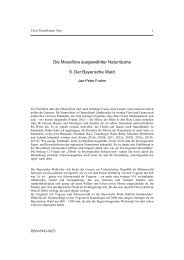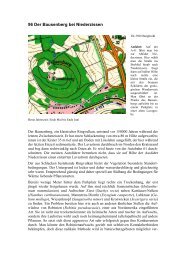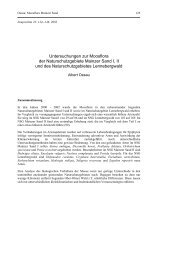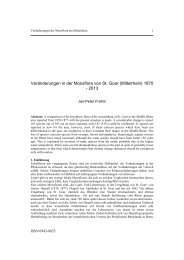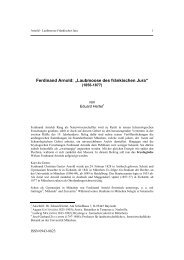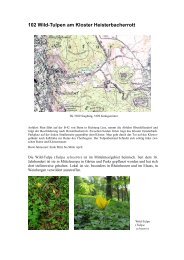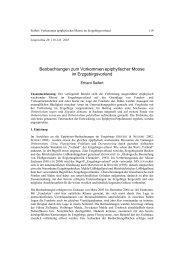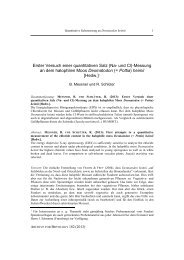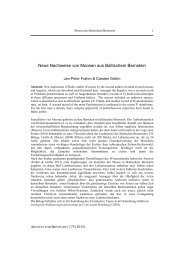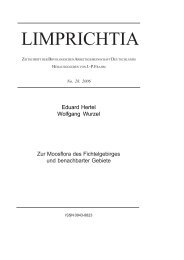Limprichtia xx: nn-nn, 2001 - Jan-Peter Frahm
Limprichtia xx: nn-nn, 2001 - Jan-Peter Frahm
Limprichtia xx: nn-nn, 2001 - Jan-Peter Frahm
Create successful ePaper yourself
Turn your PDF publications into a flip-book with our unique Google optimized e-Paper software.
Additions Moss Flora of Réunion 1<br />
Additions and corrections to the moss flora of Réunion<br />
<strong>Jan</strong>-<strong>Peter</strong> <strong>Frahm</strong><br />
Abstract: A small collection of bryophytes made during holidays on Réunion in September 2009<br />
revealed 6 species new to the island (Brachymenium acuminatum, B. dicranoides, Bryum lanatum,<br />
Campylopus clavatus, Mielichhoferia bryoides and Oxyrhynchium hians). Campylopus crateris<br />
has been found for the first time with sporophytes. These new records are incorporated in a new<br />
alphabetic list of the mosses of Réunion. Keys for the species for several genera are given.<br />
Introduction<br />
Holidays spent in 2007 in Mauritius revealed some new records and resulted in a complete moss<br />
flora of the island (<strong>Frahm</strong> et al. 2009). One year later, the Seychelles were visited, which again<br />
resulted in new records as well a new checklist (<strong>Frahm</strong> & Ho 2009.). In 2009, a short fieldtrip was<br />
made to Réunion. The results are compiled here, including some new records and comments.<br />
Furthermore, keys are given for some genera.<br />
A checklist for the bryophytes of Réunion was published by Ah-Peng & Bardat (2005). The<br />
records for the mosses were based on taxonomic revisions and some recent publications and<br />
predominantly on a compilation by Gillis Een “Mosses from Afr 3 sensu Index Muscorum”, which<br />
was available as manuscript on disk. By this way the original references are not known upon<br />
which the citation is based. This list was also available for the compilation of the moss flora of<br />
Mauritius (<strong>Frahm</strong> et al. 2009) but not used because there were too many dubious records which<br />
could not be verified by the old original literature. Furthermore many species indicated as endemic<br />
for Réunion by Ah-Peng & Bardat (2005) turned out to be more widespread, reducing the rate of<br />
endemism. Endemism rates of spore plants certainly have not that importance as compared with<br />
seed plants. First with respect to the easy modes of dispersal of spore plants such as mosses,<br />
second with respect to the young age of a neovolcanic island and third as compared with the slow<br />
evolution rate proved by fossil records and confirmed by molecular analyses, and at least with<br />
regard to the unsufficient state of knowledge of the tropical bryofloras which make it likely that a<br />
so called endemic species occurs in other parts of the world, too.<br />
A description of the island, its bryoflora and bryological exploration has been published by<br />
Wilbraham (2009).<br />
List of localities<br />
visited by the author accompanied by the lichenologist Felix Schumm in September 2009:<br />
(1) Cirque de Mafate, Aussichtspunkt am Piton Maido,21,07058 S,55,38758 E,2150, Philippia-<br />
Ulex-Hypericum Bergheide auf Lava, 07.09.2009<br />
(2) Auffahrt zum Piton Maido, La Caverne Maido,21,06200 S,55,37890 E,1935, Bachtal im<br />
durchweideten Akazienwald, 07.09.2009<br />
ARCHIVE FOR BRYOLOGY 60 (2010)
2<br />
<strong>Frahm</strong><br />
(3) Auffahrt zum Piton Caido oberhalb St. Gilles-les-Haut,21,05619 S,55,36097<br />
E,1625,Bergmischwald,07.09.2009<br />
(4) Cirque de Cilaos, nördlicher Ortsrand von Cilaos,21,13188 S,55,47138 E,1200,,08.09.2009<br />
(5) Cirque de Cilaos, Bachschlucht S von Cilaos,21,15051 S,55,47630 E,970,quellige<br />
Lavawand,08.09.2009<br />
(6) Straße St. Pierre - St. Benoit, Col de Bellevue ,21,17819S,55,58031 E,1650,durchweidetes<br />
Philippia-Gebüsch,09.09.2009<br />
(7) Straße St. Pierre - St. Benoit, Col de Bellevue, Aire de Pique Nique,21,16580 S,55,5903<br />
E,1660,Feuchtwald mit reichlich Baumfarnen,09.09.2009<br />
(8) Grand Etang SW Benoit,21,09647 S,55,65324 E,525,Sekundärwald und<br />
Wegränder,09.09.2009<br />
(9)Takamaka Schlucht am EDF Kraftwerk,21,09105 S,55,61998 E,790,feuchter Mischwald und<br />
felsige Wegränder,10.09.2009.<br />
(10) Route de Volcan, Le Cratere Commerson,21,20736 S,55,64389 E,2320,Philippia Gebüsch auf<br />
Lava,11.09.2009<br />
(11) Piton de la Fournaise, Pas de Bellecombe,21,22247 S,55,68913 E,2340,Philippia Gebüsch auf<br />
Lava am steilen Kraterrand,11.09.2009<br />
(12) Route de Volcan ,21,20143 S,55,60308 E,1730,Straßenböschung aus in Philippia Gebüsch<br />
,11.09.2009<br />
(13) Auffahrt zum Piton de la Fournaise, Nationalparkgrenze, Cryptomeria Forst, Straßenhang<br />
1730 m, 21,20143 S, 55,60308 E, 11.9.2009.<br />
(14) Auffahrt von La Petite Plaine zum Col de Bebour,21,13323 S,55,57647<br />
E,1330,Straßenböschung im Feuchtmischwald ,12.09.2009<br />
(15) Foret de Bebour, Sentier de Piton Bebour,21,128060 S,55,56962 E,1290,Feuchtmischwald<br />
,12.09.2009<br />
(16) Foret de Bebour, Umgebung Gite de Belcombe,21,06082 S,55,53667 E,14709,Straßenrand<br />
auf Beton,12.09.2009<br />
(17) Auffahrt von La Petite Plaine zum Col de Bebour,21,14621 S,55,58924E,1170,Cryptomeria<br />
Forst,12.09.2009<br />
(18) Eingang zur Cirque de Salazie,21,00097 S,55,60141 E,220,nasse Lavafelsen und<br />
Mauern,13.09.2009<br />
(19) Cirque de Salazie, Hell Bourg,21,05937 S,55,52306 E,850,an Cryptomeria<br />
japonica,13.09.2009<br />
(20) Cirque de Salazie, Ilet à Vidot,21,06982S,55,51428 E,930,Bachtal,13.09.2009<br />
(22) SE-Küste, zwischen St, Philippe und Pointe du Tremblet,21,30146 S,55,80106<br />
E,100,Lavastrom von 1986,14.09.2009<br />
(23)SE-Küste, zwischen St, Philippe und Pointe du Tremblet,21,29508 S,55,79921 E,10-<br />
140,Primärwald,14.09.2009<br />
(24) E-Küste, Anse des Cascades,21,18511 S,55,82711 E,5,Unmgebung der<br />
Wasserfälle,14.09.2009<br />
(25) Route Forestiere n. 9 des Tamarin s zw. Le Maido und Tevelav e,21,05988 S,55,36618<br />
E,1700,Akazienforste und Bachschluchten,15.09.2009<br />
(26) Wanderweg von Col de Bellevue zum Coil de Bebour zwischen Benoit und St.<br />
Pierre,21,14605 S,55,57029 E,1550,Philippia-Gebüsch mit Sphagnen,15.09.2009<br />
(27) Riviere Langvin oberhalb des gleichnamigen Ortes E St. Joseph,21,136107 S,55,64667<br />
E,130,Laubbäume und Lavagaestein ,15.09.2009<br />
List of species and comments<br />
Since the previous checklist by Ah-Peng & Bardat (2005) was systematically arranged, an<br />
alphabetical list is provided here. In this list, new records, keys and comments are incorporated.<br />
ISSN 0945-3466
Additions Moss Flora of Réunion 3<br />
Keys, even few, are included to enhance the knowledge of genera and species especially with<br />
concern to the lack of floras in the tropics. In most publications, only lists of species are given but<br />
it is not explained how the author has recognized a species or distinguished from others within the<br />
genus. The specialist has to go back to the original description of species and has gained some<br />
experience and knowledge which is taken into the grave when the bryologists dies and every other<br />
bryologists has to start again from the begi<strong>nn</strong>ing. There were and are specialists for certain genera<br />
who were able to identify species but have never provided keys or illustrations. Therefore it is<br />
absolutely necessary to make the knowledge widely available, even if the knowledge is scarce.<br />
The specimens are kept in the herbarium of the author (BONN).<br />
New records<br />
Deletions<br />
Comments<br />
(1) locality number (see list of localities above)<br />
Acroporium megasporum<br />
Aerobrydium subpiligerum (7, 9)<br />
Aerobryopsis capensis<br />
Amphidium tortuosum<br />
Anacolia laevisphaera<br />
Andreaea borbonica<br />
Andreaea tsaratananae<br />
Anisothecium cardotti<br />
Anoectangium borbonense Besch. According to Ph. Sollman, this is a local name for the<br />
cosmopolitan A. aestivum.<br />
Anoectangium mafatense<br />
Anoectangium rhaphidostegium<br />
Anomobryum filiforme Dicks. (09, 12)<br />
The only species of Anomobryum recorded from Réunion was A. laceratum. The type<br />
was collected at Hell Bourg in the Cirque de Salazie and since the species was never<br />
recorded from other parts of the world, it was regarded as endemic to Réunion. According<br />
to Ochi (1972), it differs from the almost cosmopolitan A. filiforme by shortly excurrent<br />
nerves and capsules with very short neck which is as wide as the urn, whereas the nerve<br />
of A. filiforme ends in or before the leaf apex and the neck is as long as the urn and<br />
narrower.<br />
Anomobryum filiforme is probably much common in Réunion on lava rocks, concrete<br />
walls, even asphalt of roadsides. Unfortunately only two specimens have been collected,<br />
which are definitely A. filiforme. Therefore the frequency and distribution of this species<br />
ca<strong>nn</strong>ot be described here. It could be that all Anomobryum-like specimens have been<br />
automatically named as A. laceratum before. The illustration of the capsule A. laceratum<br />
by Ochi (1972) gives not the impression of an Anomobryum and therefore this species<br />
seems to be dubious.<br />
The species can be confused with Aongstroemia julacea in the field, which has short (2:1)<br />
upper laminal cells.<br />
Anomodon pseudotristis<br />
Anomodon tristis<br />
Aongstroemia filiformis (7) common along roadside banks. Resembles much Garckea comosa in<br />
appearance but has very conspicuous sheathing leaf bases which are abruptedly<br />
contracted to the leaf apex.<br />
Aongstroemia julacea (10) Easily taken for an Anomobryum but differing by very short laminal<br />
cells.<br />
ARCHIVE FOR BRYOLOGY 60 (2010)
4<br />
<strong>Frahm</strong><br />
Astomum borbonicum<br />
Atractylocarpus madagascariensis (12, 26) On branches of Philippia.<br />
Atrichum androgynum (15)<br />
Barbula indica (1)<br />
Barbula unguiculata<br />
Bartramia Key to the species reported from Réunion based upon Fransén (2004). All species in<br />
sect. Vaginella with broad sheathing whitish leaf bases.<br />
1 Plants strongly appressed when dry. Leaf tips easily broken. B. gigantea<br />
1* Leaves erect patent or crisp. Leaf tips not broken. 2<br />
2 Cells of sheathing leaf base smooth. B. ithyphylla<br />
2* Cells of sheathing leaf base porose, thick walled. B. longifolia<br />
Bartramia gigantea (1)<br />
Bartramia ithyphylla (11)<br />
Bartramia longifolia<br />
Blindia. Key for the species from Réunion from Bartlett & Vitt (1986)<br />
1 Moist setae cygneous B. magellanica<br />
1* Moist setae erect to flexuose B. acuta<br />
Blindia acuta (25)<br />
“When sterile, both species are sometimes difficult to distinguish: Blindia acuta has short<br />
upper leaf cells (8-25µm long) and generally is a smaller plant (up to 1,5 cm long, leaves<br />
1,5-2,5(3.0) mm long), whereas B. magellanica usually has longer upper leaf cells (10)18-<br />
40(50) µm and is a taller plant, up to 3 cm long (leaves (2.)3.0-5.0 mm long). (Bartlett &<br />
Vitt 1964).<br />
Blindia magellanica<br />
Brachymenium acuminatum (25)<br />
Easily identified in the field by its lustrous colour.<br />
Brachymenium dicranoides (1)<br />
One of the very few species within the genus with a not excurrent costa.<br />
Brachymenium exile (B. gemmiferum fide Müller 2000)<br />
Brachymenium eurychelium<br />
Brachymenium exile<br />
Brachymenium gemmiferum<br />
Brachymenium leptophyllum<br />
Brachymenium pulchrum<br />
Brachymenium spathidophyllum<br />
This species is regarded by Ochi (1972) as a synonym of B. eurychelium Müll.Hall. ex<br />
Besch. It is not endemic to Réunion but was also found in Rodriguez. Ochi (1972) wrote:<br />
“This may not be a good species”, because it is very similar to the widespread B.<br />
longicolle, which has also been found on Mauritius.<br />
Brachythecium borgenii<br />
Brachythecium chauvetii<br />
Brachythecium decurrens<br />
Brachythecium plumosum<br />
Brachythecium valentinii<br />
Breutelia. Key to the species reported from Réunion after de Sloover (1975)<br />
1 Leaves with distinct widened base, abruptedly narrowed into the acumen, strongly<br />
longitudinally plicate. 2<br />
1* Leaf base less distinct or not widened, if less distinct, not abruptedly narrowed into the<br />
acumen, not or slightly plicate. 4<br />
2 Leaves > 6mm, mostly 7-9 mm long or longer B. stuhlma<strong>nn</strong>ii<br />
2* Leaves shorter,
Additions Moss Flora of Réunion 5<br />
3 Leaves 4,5 mm long. Stems not much branched. B. borbonica<br />
4 Leaf base widened. Leaves 3 – 3,5 mm long. B. gnaphalea<br />
4* Leaf base not widened. 5<br />
5 Leaves lanceolate, widest above base, ovate, shortly pointed. B. magdalenae<br />
5* Leaves triangular, widest at base, leaf tip as long as the lamina. B. stenodictyon<br />
Breutelia borbonica (14)<br />
Breutelia gnaphalaea (25)<br />
Breutelia magdalenae<br />
Breutelia perrieri<br />
Breutelia stenodictyon<br />
Breutelia stuhlma<strong>nn</strong>ii (13)<br />
Bryohumbertia filifolia (Hornsch.) J.-P- <strong>Frahm</strong> (Campylopus filifolius)<br />
The species is known from a collection leg. Robillard on Mauritius but since it is a<br />
neotropical species, the record is doubtful.<br />
Bryoerythrophyllum campylocarpum<br />
Bryum (Key for the species reported from Réunion modified from Ochi1972)<br />
1 Plants silvery, julaceous 2<br />
1* Plants otherwise 3<br />
2 Plants slender, excurrent nerve reflexed B. lanatum<br />
2* Plants rigide, excurrent nerve straight, appressed. B. argenteum<br />
3 Leaves in a terminal rosette 4<br />
3* Leaves not in a rosette 5<br />
4 Plants without subterraneous stolons. Leaves 7 mm long. Nerve in transverse section with<br />
stereids. Bryum aubertii<br />
5 Leaves with obtuse apex, concave, areolation lax. B. cellulare<br />
5* Leaves acuminate 6<br />
6 Leaf margins bordered by elongate cells, large plants. Neck of capsule longer than the<br />
urn. 7<br />
6* Leaf margins not bordered, small plants. Neck of capsule half as long than the urn.<br />
B. coronatum<br />
7 Costa longly exurrent. Leaves lanceolate (4:1) B. cadetii<br />
7* Costa percurrent or shortly excurrent. Leaves ovate (2:1). B. pseudotriquetrum<br />
Bryum apiculatum (nitens)<br />
Bryum argenteum<br />
Bryum aubertii<br />
Bryum billardieri (9,22)<br />
Common species on rocks, rock fissures and soil.<br />
Bryum cadetii<br />
A dubious taxon described by Bizot (1974), known only from the type collection in<br />
Réunion. The author placed it into the sect. Trichophora although the leaves are not<br />
contorted when dry and compared it with B. do<strong>nn</strong>ianum and B. pachyloma, from which it<br />
shall be distinguished by the longly excurrent nerve and the not contorted leaves.<br />
Bryum cellulare (5)<br />
Bryum coronatum<br />
Bryum lanatum Hedw.<br />
Bois Marron. G. de Isle 1875 (Bescherelle 1880) as B. argenteum var. lanatum. This<br />
taxon is very distinct from B. argenteum by its very small size, the recurved excurrent<br />
nerves and its occurrence in natural habitats.<br />
ARCHIVE FOR BRYOLOGY 60 (2010)
6<br />
<strong>Frahm</strong><br />
Bryum pseudotriquetrum (8, lake shore)<br />
Bryum sp. (sect. Trichophora) (1, # REU-350))<br />
This specimen keys out to B. donianum from the Mediterranean. It is has equally foliate<br />
stems 3 cm long, slightly comose at tips, ovate leaves with shortly excurrent costa, and a<br />
border 3-4 cells wide, serrate at tips.<br />
Bryum sp. (18, REU-354)<br />
Plants comose at tips, similar to B. billardieri, but plants much smaller (leaves 1.5 mm)<br />
and leaves not bordered, hardly involute.<br />
Callicostella fissidentella<br />
Callicostella salaziae<br />
Calymperes hispidum<br />
Calymperes palisotii<br />
Calymperes taitense<br />
Calyptothecium acutifolium<br />
Calyptrochaeta asplenioides (9)<br />
Campylopus<br />
A key to the species reported from Réunion:<br />
1 Basal laminal cells hyaline, translucent, thin walled. 2<br />
1* Basal laminal cells incrassate, chlorophyllose 11<br />
2 Nerves ending in a hyaline hairpoint 3<br />
2* Nerve excurrent in a concolorous point 8<br />
3 Hairpoints recurved or reflexed. 4<br />
3* Hairpoints straight. 5<br />
4 Hairpoints recurved when wet (appressed when dry or in male plants), very long, about<br />
1/3 of total leaf length,. Sterile plants appressed foliate Male plants with terminal buddy<br />
perichaetia. Capsules asymmetric, strumose; upper laminal cells oval; costa lamellose at<br />
back with 2-3 cells, in transverse section with ventral substereids. Common species, much<br />
varying in size and colour (from green to black). aureonitens<br />
4* Hairpoints reflexed. Austral species, so far known from only one collection. introflexus<br />
5 Stems densely foliate 6<br />
5* Stems not julaceous. 7<br />
6 Hyaline hairpoint serrate. Stems not branched. julaceus<br />
6* Hyaline hairpoint almost smooth. Stems branched smaragdinus<br />
7 Nerve with dorsal lamellae 3-4 cells high. pilifer<br />
7* Nerve only ridged at back. schmidii, clavatus<br />
8 Alar cells protruding into the costa; Upper laminal cells subquadrate, small; transverse<br />
section of costa with large ventral hyalocysts. Robust plants with long leaf tips. jamesonii<br />
8* Alar cells not protruding into the costa 9<br />
9 Upper laminal cells oval. nivalis<br />
9* Upper laminal cells not oval. 10<br />
10 Upper laminal cells short rectangular to oblique (2:1). Les tip not canaliculate.<br />
hildebrandtii<br />
10* Upper laminal cells rectangular (4:1). Leaf tip long and narrow, canaliculated.<br />
pyriformis<br />
11 Nerve excurrent in a hyaline hairpoint, which is almost smooth. Basal laminal cells thick<br />
walled and pitted; upper laminal cells elongate oval; transverse section of costa with small<br />
ventral stereids. Blackish plants especially on lava rocks. crateris<br />
11* Excurrent nerve concolorous smooth or subhyaline and roughly dentate. 12<br />
12 Excurrent nerve concolorous or subhyaline, roughly dentate. Basal laminal cells<br />
rectangular, quadrate at margins; upper laminal cells quadrate to oblique. robillardei<br />
12* Excurrent leaf tip concolourous, 13<br />
ISSN 0945-3466
Additions Moss Flora of Réunion 7<br />
13 Excurrent nerve almost smooth. Leaf tip very longly acuminate, costa longly excurrent.<br />
Basal laminal cells porose, bordered by some hyaline elongate cell rows. Alar cells very<br />
conspicuous. Costa with ventral stereids. Robust plants arcuatus<br />
13* Excurrent nerve serrate 14<br />
14 Basal laminal cells smooth. 15<br />
14* Basal laminal cells pitted. Costa with ventral stereids 16<br />
15 Plants small, usually not larger than 1 cm high, without flagellae. nanophyllus<br />
15* Plants robust 4-5 cm high, with microphyllous flagellae. flexuosus<br />
16 Plants interruptedly foliate. trachyblepharon<br />
16* Plants not interruptedly foliate 17<br />
16 Upper laminal cells quadrate. Lamina reaching almost the leaf tip. arctocarpus<br />
16* Upper laminal cells oval. Lamina vanishing in upper part of the leaf. thwaitesii<br />
Campylopus arctocarpus ssp. madegassus (2, 25)<br />
Campylopus arcuatus (2, 6, 14, 25)<br />
Campylopus aureonitens (1, 6, 11, 12, 25) is the most common species of the genus on Réunion. It<br />
grows on lava rocks from sea level to 2500 m, even on secondary habitats such as banks<br />
of asphalt roads. It replaces C. pilifer, which is usually found in the tropics in such<br />
habitats. Campylopus aureonitens has possibly reached the island before C. pilifer and has<br />
occupied its ecological niche. The species is an East African element.<br />
Campylopus bartramiaceus The record is based upon Eens manuscript on disk but lacks any<br />
basis. The species is subantarctic and its occurrence in Réunion is unlikely. The name has<br />
also been used for C. hildebrandtii.<br />
Campylopus clavatus (12) A blackish species with appressed foliate stems and leaves with<br />
hyaline basal laminal cells and long hairpoints. In this respect similar to the very common<br />
C. aureonitens but the hairpoints are not recurved, the costa is not lamellose and the<br />
capsules are symmetric, oval with a scabrous base (subg. Thysanomitrion). The plants<br />
have also buddy male perichaetia like C. aureonitens. An austral species which is<br />
common in the southern hemisphere.<br />
Campylopus crateris (11, 12) is a conspicuously blackish species with hairpoints growing on bare<br />
rocks at high altitudes. The type locality is Cratere Commerson, where it is still found as<br />
well as in the whole area of the Piton de la Fournaise. It is found else only rarely in Kenia,<br />
Madagaskar and the Comores (each one record) and has the largest population on<br />
Réunion.<br />
The species was known so far only in sterile condition, one specimen (REU 217 from loc.<br />
11), however, showed sporophytes for the first time. The seta is redbrown, 5-7 mm long<br />
and sinuose. The capsule is 1,5 mm long, ovate, furrowed when ripe or empty, light<br />
brown to brown in age, and scabrous at base. The operculum is 0,5 mm long and oblique.<br />
The peristome is reddish at base and ends in filiform tips. All characters support that this<br />
species belongs to the subg. Thysanomitrion as already suggested by <strong>Frahm</strong> (1984).<br />
Campylopus flexuosus (6, 13, 25)<br />
Campylopus flexuosus var. incacorralis. This tropical alpine species has been recorded by Een<br />
from a Tamarind forest which makes the record dubious.<br />
Campylopus fragilis<br />
Campylopus hildebrandtii (11)<br />
Campylopus introflexus<br />
Campylopus jamesonii (2, 14)<br />
Campylopus julaceus ssp. arbogasti (14)<br />
Campylopus nanophyllus<br />
Campylopus nivalis (11)<br />
Campylopus pilifer (1, 6, 17, 22)<br />
ARCHIVE FOR BRYOLOGY 60 (2010)
8<br />
<strong>Frahm</strong><br />
Campylopus praetermissus. This record is based on a collection made by Een. As in other records<br />
of Campylopus specimens, the author has discussed to which extend the specimen agrees<br />
with the description or not and in the case of new records for Réunion, the identification<br />
must be questioned.<br />
Campylopus pyriformis (2)<br />
Campylopus robillardei (25, 26)<br />
Campylopus schmidii (10, 13, 25)<br />
A species with hyaline hairpoints, hyaline basal laminal cells and oval upper laminal cells like C.<br />
pilifer or C. aureonitens. It is distinguished from these species by the smooth back of the<br />
costa, which is only slightly ridged, whereas both other species have lamellose costas.<br />
Campylopus pilifer and schmidi are closely related and vicariant species in the new world<br />
and Africa viz. tropical Asia. I spite of the similarity, C. aureonitens belongs to another<br />
group of species because it has symmetric capsules which are scabrous at base, whereas<br />
the other species have curved capsules.<br />
Campylopus smaragdinus<br />
Campylopus thwaitesii<br />
Campylopus trachyblepharum<br />
Cardotiella appendiculata<br />
Cardotiella subappendiculata<br />
Catagonium nitens<br />
Ceratodon purpureus<br />
Chaetomitrium borbonicum<br />
Cyclodictyon albicans<br />
Cyclodictyon borbonicum<br />
Cyclodictyon brevifolium<br />
Cyclodictyon perrottetii<br />
Cyclodictyon vesiculosum<br />
Daltonia angustifolia<br />
Daltonia latimarginata<br />
Daltonia onraedtii<br />
Dicranella cratericola<br />
Dicranella flavipes<br />
Dicranella subsubulata<br />
Dicranoloma billardierei<br />
Dicranoloma borbonicum<br />
Didymodon maschalogena<br />
Distichophyllum mascarenicum<br />
Ditrichum. Key to the species in Réunion based upon the Seppelt (1982).<br />
1 Leaves gradually contracted from base. Leaf tips not twisted. Capsule 4 mm long.<br />
D. difficile Austral species extending to SE-Asia.<br />
2 Leaves abruptedly contracted from base. Leaf tips twisted when dry. Capsule 1-2 mm<br />
long. D. punctulatum Species from Australia and New Zealand<br />
Ditrichum difficile (2,13) Widespread on roadside banks.<br />
Ditrichum punctulatum<br />
Ectropothecium regulare<br />
Ectroprothecium occulum<br />
Ectroprothecium valentinii<br />
Ectroprothecium viridulum<br />
Entodon dregeanus<br />
Entodon geminidens<br />
Entodon macropodus<br />
ISSN 0945-3466
Additions Moss Flora of Réunion 9<br />
Entosthodon. Key to the species reported from Réunion<br />
1 Capsule symmetric, erect. Leaves apiculate, ending in a short point. E. borbonicus<br />
1* Capsule slightly asymmetric, inclined, leaves with long hairpoint. E. lepervancei<br />
Entosthodon borbonicus (12, 15)<br />
Widespread on roadside banks. Similar is E. mauritianus, which is described as<br />
synecious, whereas E. borbonicus shall be autoecious. The relation between both species<br />
has to be studied.<br />
Entosthodon lepervanchei<br />
Eurhynchium acicladium<br />
Eustichia longirostris<br />
Felipponea assimilis<br />
Fissidens asplenioides<br />
Fissidens brevifrons<br />
Fissidens crispulus<br />
Fissidens darntyi<br />
Fissidens ellipticus<br />
Fissidens intramarginatus<br />
Fissidens ovatus<br />
Fissidens palmifolius<br />
Fissidens pellucidus<br />
Fissidens planifrons<br />
Fissidens plumosus<br />
Fissidens pseudoplumosus<br />
Fissidens sciophyllus<br />
Floribundaria floribunda (20)<br />
Floribundaria vaginans<br />
Funaria hygrometrica<br />
Garckea flexuosa<br />
Grimmia eongata<br />
Grimmia laevigata<br />
Grimmia longirostris<br />
Gymnostomiella vernicosa<br />
Hedwigidium integrifolium (25)<br />
The genera Hedwigidium, which is monotypic with H. integrifolium, and Braunia with<br />
about a dozen species worldwide both inhabit open bare rocks and are usually<br />
dististinguished by sporophytic characters in the way that Braunia has a longer Seta with<br />
an elongate capsule and Hedwigidium a reduced seta and an ovate capsule. The plants<br />
are, however frequently sterile and then difficult to separate. As figured out by <strong>Frahm</strong><br />
(1974) both genera can also be distinguished vegetatively as follows:<br />
1 Leaves with flat margin; laminal cells with dense high papillae, opaque; leaf tips blunt,<br />
dolphin nose shaped, entire Braunia<br />
1* Leaves margins rolled in almost along the whole leaf; laminal cells with low papillae,<br />
translucent: leaf lanceolate, tips gradually narrowed; often slightly dentate. Hedwigidium<br />
Hildebrandtiella rotundifolia<br />
Hildebrantiella phleoides<br />
Holomitrium borbonicum<br />
Holomitrium cyclindraceum<br />
Homaliodendron exiguum<br />
Hookeria splachnifolia<br />
Hylocomnium brevirostre<br />
Hymenostylium recurvirostrum<br />
ARCHIVE FOR BRYOLOGY 60 (2010)
10<br />
<strong>Frahm</strong><br />
Hymenostylium scaturiginosum<br />
Hyophila involuta (9) widespread<br />
Hypnum bicolor<br />
Hypnum boryanum<br />
Hypnum cupressiforme<br />
Hypnum jutlandicum<br />
Hypnum macrogynum<br />
Hypnum radiatum<br />
Hypopterygium tamarisci<br />
Isopterygium citrinellum<br />
Isopterygium intortum<br />
Isopterygium molle<br />
Isopterygium radicans<br />
Jaegerina solitaria (9)<br />
The only species of the genus in Réunion (Argent 1973).<br />
Leiomela bartramioides (12) Differs from Bartramia and Anacolia by not differentiated basal<br />
laminal cells and very long leaf apices.<br />
Leiomitrium plicatum<br />
Lepidopilidium caespitosa<br />
Lepidopilidium flexuosum<br />
Lepidopilidium hirsutum<br />
Lepidopilidium isleanum<br />
Leptodon fuciformis<br />
Leptodontium Key for the species reported from Réunion after De Sloover (1987)<br />
1 Stems smooth. 2<br />
1 Stems with longitudinal furrows (crenulated in transverse section 3<br />
2 Plants 3 cm, leaves > 3 mm. L. viticulosoides<br />
3 Uppermost laminal cells elongate, smooth. L. pungens<br />
3* Uppermost laminal cells short, papillose. L. longicaule<br />
Leptodontium flexifolium<br />
Leptodontium longicaule (2)<br />
Leptodontium pungens<br />
Leptodontium viticulosoides<br />
Leptophascum leptophyllum<br />
Leptotrichella lutaria<br />
Leucobryum boryanum<br />
Leucobryum isleanum<br />
Leucobryum javense<br />
Leucobryum juniperoideum (9)<br />
Leucobryum mayottense<br />
Leucoloma bifidum<br />
Leucoloma boivinianum<br />
Leucoloma candidulum<br />
Leucoloma capillifolium<br />
Leucoloma cinclidotioides<br />
Leucoloma cirrosulum<br />
Leucoloma fuscifolium<br />
Leucoloma lepervancheri<br />
Leucoloma longifolium<br />
Leucoloma mafatense<br />
ISSN 0945-3466
Additions Moss Flora of Réunion 11<br />
Leucoloma membranaceum<br />
Leucoloma onraedtii<br />
Leucoloma persecundum<br />
Leucoloma rutenbergii<br />
Leucoloma sanctae-mariae<br />
Leucoloma seychellense<br />
Leucoloma sinuosulum<br />
Leucoloma subcespitulans<br />
Leucomium strumosum<br />
Leucophanes angustifolium (23)<br />
Leucophanes hildebrandtii<br />
Leucophanes rodriguezii<br />
Lopidium struthiopteris<br />
Macrocoma tenuis<br />
Macrohymenium acidodon<br />
Macromitrium belangeri<br />
Macromitrium fasciculare<br />
Macromitrium fimbriatum<br />
Macromitrium gimalacii<br />
Macromitrium mauritianum<br />
Macromitrium pallidum<br />
Macromitrium rufescens<br />
Macromitrium scleropodium<br />
Macromitrium serpens<br />
Macromitrium voeltzkowii<br />
Meiothecium madagascariense<br />
Mielichhoferia borbonica<br />
Mielichhoferia bryoides (1,2)<br />
Plants resembling a species of Pohlia with lanceolate leaves, serrate at tips, narrow<br />
elongate rhomboideal cells, a costa ending before or in the leaf tip, but yellow brown,<br />
inclined and asymmetric capsules with convex operculum. A species known from South<br />
Africa, New Zealand and Australia.<br />
Mittenothamnium limosum<br />
Mittenothamnium madagassum<br />
Mittenothamnium microthamnioides<br />
Mittenothamnium reptans<br />
Neckera valentiana<br />
Neckeropsis lepineana<br />
Octoblepharum albidum<br />
Orthodontium loreifolium<br />
Orthostichidium involutifolium<br />
Orthostichidium pentasticha<br />
Orthostichopsis longinervis<br />
Orthostichopsis subimbricata<br />
Orthostichopsis sublivens<br />
Oxyrhynchium hians (25, roadside next to Cryptomeria forest on asphalt)<br />
Most likely introduced like Pseudoscleropodium purum. The only Eurhynchium s.lat.<br />
reported from Réunion is Eurhynchium acicladum, which is described by 1880 as similar<br />
to Eurhynchium crassinervium.<br />
Palamocladium leskeoides<br />
Papillaria africana (14)<br />
ARCHIVE FOR BRYOLOGY 60 (2010)
12<br />
<strong>Frahm</strong><br />
Pelekium versicolor<br />
Philonotis bescherellei is a nomen nudum and has therefore to be deleted from the list of species<br />
and endemics<br />
Philonotis gracilescens<br />
Philonotis hastata<br />
Philonotis mauritiana<br />
Philonotis perigonialis<br />
Philonotis scabrifolia<br />
Philonotis submarchica<br />
Phyllodon perplanicaulis<br />
Phyllodon truncatulus<br />
Phyllogonium fulgens<br />
Phyllogonium viride.<br />
Both species are mainly neotropical. They are definitely no endemic of Réunion as<br />
indicated by Ah-Peng & Bardat (2005).<br />
Phyllogonium viscosum<br />
Physcomitrium spathulatum<br />
Pilotrichella isleana<br />
Pilotrichella mascarenica<br />
Pilotrichella phleoides<br />
Pi<strong>nn</strong>atella minuta<br />
Plagiomnium rhynchphorum<br />
Plagiothecium nitens<br />
Pogonatum (key based on Hyvönen 1989)<br />
1 Leaves entire or with small indistinct teeth. urnigerum<br />
1* Leaves serrate or dentate 2<br />
2 Apical cells of lamellae extremely incrassate perichaetiale ssp. oligodus<br />
2* Apical cells of lamellae not or only the outer walls incrassate 3<br />
3 Giant plants, > 20 cm high, lamellae only 2 cells high convolutum<br />
3* Smaller plants, lamellae more numerous 4<br />
4 At least some apical cells of lamellae double gracilifolium<br />
4* Apical cells not double. belangeri<br />
Pogonatum belangeri (15)<br />
Pogonatum convolutum (15)<br />
Easily recognized by its large size (to 30 cm) and lamellae only 2 cells high. A species<br />
confined to Madagascar, Mauritius and Réunion.<br />
Pogonatum gracilifolium (3,15)<br />
Pogonatum perichaetiale<br />
Pogonatum proliferum<br />
The record by Een (1993) ca<strong>nn</strong>ot be verified. It is listed in the Index Muscorum with “As.<br />
3” and not indicated by Hyvönen (1989) for Réunion or “Afr. 3”.<br />
Pogonatum urnigerum<br />
Pogonatum usambaricum<br />
Polytrichum<br />
1 Leaves ending in a hyaline hairpoint. Small plants, a few cm high. Apical cells of costal<br />
lamellae entire. piliferum<br />
1* Leaves ending in a concolorous, green or brownisch tip. Plants larger, up to 30 cm high. 2<br />
2 Apical cell of costal lamellae notched. 3<br />
2* Apical cell not notched, rounded. formosum<br />
3 Notch of apical cell of costal lamellae half moon shaped. commune<br />
3* Notch deeply incised, bifid, rarely also entire or flattened. subpilosum<br />
ISSN 0945-3466
Additions Moss Flora of Réunion 13<br />
Polytrichum commune (22)<br />
Polytrichum formosum<br />
Polytrichum piliferum<br />
Polytrichum subpilosum (1,6,15)<br />
Polytrichum commune and subpilosum are closely related and seem to differ only in microscopic<br />
characters; the sporophyte seems to be almost identical. It seems to be that the capsules of<br />
P. subpilosum are longer, cubic and have a broad gap between urn and apophysis.<br />
whereas they are more cubic in P. commune, which has only a furrow between the urn<br />
and the apophysis. De Sloover (1986) differentiates both species also by margins of<br />
leaves with small teeth between larger ones (subpilosum) and no small teeth between the<br />
larger ones (commune), but also commune has smaller and larger teeth , however, not as<br />
pronounced. Polytrichum subpilosum is a common species (and apparently more frequent<br />
than P. commune) along roadside banks and in forests especially at lower altitudes but<br />
going up to the subalpine belt. Polytrichum commune grows in habitats such as rocks in<br />
lava flows, which seem to be dry and in sharp contrast to its habitat (swamps) in<br />
temperate regions.<br />
Porothamnium variifolioides<br />
Porotrichum elongatum<br />
Porotrichum madagassum<br />
Porotrichum stipitatum<br />
Porotrichum usagarum<br />
Prionodon ciliatus<br />
Pseudephemerum nitidium<br />
Pseudopohlia microstoma<br />
Pseudoscleropodium purum<br />
Pseudosymblepharis bombayensis<br />
Pseudosymblepharis circinatula<br />
Pterogonium gracile<br />
Ptychomitrium subcrispatum<br />
Pyrrhobryum spiniforme (3)<br />
Pyrrhobryum spiniforme var. brevifolium (8,23)<br />
This variety is conspicuously smaller. The leaves have only half size (3 instead of 6 mm<br />
length).<br />
Pyrrhobryum spiniforme<br />
Racomitrium lanuginosum<br />
Racomitrium lepervanchei<br />
Indicated for Réunion by de Sloover (1977) but not mentioned by Ah-Peng & Bardat<br />
(2005)<br />
Racomitrium membranaceum<br />
Is not mentioned by de Sloover (1977) as indicated by Ah-Peng & Bardat (2005).<br />
Racomitrium subsecundum<br />
Was listed for Réunion by de Sloover (1977) as R. alare.<br />
Racopilum africanum<br />
Racopilum ayresii<br />
Not endemic to Réunion as indicated by Ah-Peng & Bardat (2005).but also found on<br />
Mauritius.<br />
Racopilum capense<br />
Racopilum mauritianum<br />
Racopilum schmidii<br />
Racopilum tomentosum<br />
Radulina borbonica<br />
ARCHIVE FOR BRYOLOGY 60 (2010)
14<br />
Rhacocarpus purpurascens<br />
Rhaphidorrhynchium crispans<br />
Rhaphidorrhynchium rubricaule<br />
Rhodobryum commersonii<br />
Rhodobryum giganteum<br />
Rhynchostegiella tenelliformis<br />
Rhynchostegium comorae<br />
Rhynchostegium distans<br />
Rhyncostegium pseudodistans<br />
Rutenbergia borbonica<br />
Rutenbergia prionodon<br />
Schistidium apocarpum<br />
Schlotheimia angulosa<br />
Schlotheimia badiella<br />
Schlotheimia brachyphylla<br />
Schlotheimia fornicata<br />
Schlotheimia illecebra<br />
Schlotheimia malacophylla<br />
Schlotheimia microcarpa<br />
Schlotheimia richardii<br />
Schlotheimia robillardi<br />
Schlotheimia squarrosa<br />
Schlotheimia subfornicata<br />
Schwetschkea grateloupii<br />
Sematophyllum crassiusculum<br />
Sematophyllum schimperi<br />
Sematophyllum sinuosulum<br />
Sematophyllum subpi<strong>nn</strong>atum<br />
Serpotorella chenagonii<br />
Serpotorella cyrtophylla<br />
Sphagnum bourbonense<br />
Sphagnum capense<br />
Sphagnum capillifolium<br />
Sphagnum ceylonicum<br />
Sphagnum condensatum<br />
Sphagnum davidii<br />
Sphagnum ericetorum<br />
Sphagnum perichaetiale<br />
Sphagnum rutenbergii<br />
Sphagnum strictum<br />
Sphagnum truncatum<br />
Sphagnum tumidulum<br />
Sphagnum violascens<br />
Squamidium brasiliense<br />
Stereophyllum radiculosum<br />
Symphyodon pygmaeus<br />
Syrrhopodon armatus<br />
Syrrhopodon asper<br />
Syrrhopodon gardneri<br />
Syrrhopodon gaudichaudii<br />
Syrrhopodon involutus<br />
<strong>Frahm</strong><br />
ISSN 0945-3466
Additions Moss Flora of Réunion 15<br />
Syrrhopodon mahensis Besch. Is not an endemic as indicated by Ah-Peng & Bardat<br />
(2005).but described from Mahé (Seychelles).<br />
Syrrhopodon mauritianus<br />
Syrrhopodon parasiticus<br />
Syrrhopodon prolifer<br />
Syrrhopodon rodriguezii<br />
Taxithelium pseudo-amoenum<br />
Tayloria isleana<br />
Tayloria orthodonta<br />
Thuidium Key to the species reported from Réunion, partly from Touw (1976)<br />
1 Terminal cell of branch leaf smooth. T. tamariscinum<br />
1* Terminal cells of Branch leaf pluripapillose. 2<br />
2 Stem leaves ending in 1-3 hyaline cells. T. aculeoserratum<br />
2* Stem leaves ending in 3-4 hyaline cells. T. assimile<br />
Thuidium aculeoserratum<br />
Thuidium assimile<br />
Thuidium tamariscinum (14)<br />
Tortella humilis (12) Can be recognized by the lingulate leaves with hyaline leaf base, which does<br />
not extend V-shaped along the margins as in other species of the genus.<br />
Tortella vernicosa<br />
Trachyphyllum inflexum<br />
Trachypodopsis serrulata<br />
Trachypus bicolor<br />
Trematodon borbonicus<br />
Trematodon paradoxus<br />
Trematodon subambiguus<br />
Trichosteleum adhaerens<br />
Trichosteleum constrictum<br />
Trichosteleum debettei<br />
Trichosteleum pervilleanum<br />
Trichostomum brachydontium (4)<br />
Trichostomum cardotii<br />
Trichostomum crispulum<br />
Trichostomum tenuirostre (1)<br />
Ulota fulva<br />
Vesicularia rodriguezii<br />
Vesicularia scaturigina<br />
Vesicularia subspherica<br />
Warburgiella leptorrhyncha<br />
Weissia ayresii<br />
Weissia controversa<br />
Weissia ricciae<br />
Wijkia protensa<br />
Zygodon intermedius<br />
Zygodon reinwardtii<br />
Key to the Meteoriaceae from Réunuion<br />
1 Leaves ecostate, ovate Orthostichella pentasticha<br />
1* Leaves costate, ending in a long acumen. 2<br />
ARCHIVE FOR BRYOLOGY 60 (2010)
16<br />
<strong>Frahm</strong><br />
2 Laminal cells with papillae over the cell walls; Leaves apressed when dry, strongly<br />
auriculate Papillaria africana<br />
2* Laminal cells with papillae over the lumen, leaves widespread, auriculate or not. 3<br />
3 Leaves not auriculate, margins plane. Floribundaria floribunda, vaginans<br />
3* Leaves auriculate, margins undulate ^ 4<br />
4 Laminal cells oval to elliptic, costa to midleaf. Aerobryopsis capensis<br />
4* Laminal cells lineal, costa reaching to leaf tip. Aerobryidium subpiligerum<br />
References<br />
Bescherelle, E. 1878. Florule bryologique de la Réunion, de Maurice, et des autres îles austro-<br />
africaines de l’Ocean Indien. A<strong>nn</strong>ales des Sciences Naturelles, Botanique 9(6): 291-380.<br />
Argent, G.C.G. 1973. A taxonomic study of African Pterobryaceae and Meteoriaceae I.<br />
Pterobryaceae. Journal of Bryology 7: 353–378.<br />
Bartlett, J.K., Vitt, D.H. 1986. A survey of the species in the genus Blindia. New Zealand Journal<br />
of Botany 24: 203-246.<br />
Bescherelle, E. (1880). Florule bryologique de la Réunion, de Maurice et des autres îles austroafricaines<br />
de l’Océan Indien. A<strong>nn</strong>ales des Sciences Naturelles, Botanique 10(6): 233-333.<br />
<strong>Frahm</strong>, J.-P. 1976. Ein Fund von Hedwigidium integrifolium (P. Beauv.) Dix. in den Südalpen.<br />
Nova Hedwigia XXVII: 773-780.<br />
<strong>Frahm</strong>, J.-P. 1984. Campylopus Brid. I. Subgenus Thysanomitrion (Schwaegr.) Kindb. emend. J.-<br />
P. <strong>Frahm</strong>. Nova Hedwigia 34: 585-621.<br />
<strong>Frahm</strong>, J.-P., Ho, B.-C. 2009. A new contribution to the moss flora of the I<strong>nn</strong>er Seychelles.<br />
Archive for Bryology 38:1-16.<br />
<strong>Frahm</strong>, J.-P., O´Shea, B.J., Ho, B.C. 2009. The Moss Flora of Mauritius. Archive for Bryology 51:<br />
1-26.<br />
Fransén, S. 2004. A taxonomic revision of extra-Neotropical Batramia section Vaginella C. Müll.<br />
Lindbergia 29: 73-107.<br />
Hyvönen, J. 1989. A synopsis of genus Pogonatum (Polytrichacaeae, Musci). Acta Botanica<br />
Fe<strong>nn</strong>ica 138: 1-87.<br />
Ochi, H. 1972. A revision of the African Bryoideae, Musci. J. Fac. Educ. Tottori Univ. Nat. Sci.<br />
23: 1-126, Resp. 24: 21-50<br />
Müller, F. 2000. Additions to the bryophyte flora of Réunion (East African islands). Tropical<br />
Bryology 18: 91-95.<br />
Seppelt, R.D. 1982. A Monographic Revision of Ditrichum I. J. Hattri Bot. Lab. 51: 99-150.<br />
Shaw, A.J., Allen, B., Buck et al., W.R. 1998. New species of Bryacaeae (Mielichhoferia,<br />
Brachymednium) from Costa Rica and Réunion. The Bryologist 101: 600-604.<br />
Sloover, J.L- de 1975.Note de bryologie africaine. IV. Breutelia. Bull. Jard. Bot. Nat. Belg. 45:<br />
237-271.<br />
Sloover, J.L- de 1977.Note de bryologie africaine. IX. Andreaea, Racomitrium, Gymnostomiella,<br />
Thuidium. Bull. Jard. Bot. Nat. Belg. 47: 155-181.<br />
Sloover, J.L. de 1986. Note de bryologie africaine. XIII Polytrichaceae. Bull. Jard. Bot. Nat. Belg.<br />
57: 425-451.<br />
Sloover, J.L- de 1987.Note de bryologie africaine. XIV. Leptodontium. Bull. Jard. Bot. Nat. Belg.<br />
56: 241-300.<br />
Touw, A. 1976. A taxonomic reavision of Thuidium, Pelekium, and Rauiella (Musci: Thuidiaceae)<br />
in Africa South of the Sahara. Lindbergia 3: 135-195.<br />
Wilbraham. J. 2009. Bryophytes & volcanoes: La Réunion island. Field Bryology 97: 24-31.<br />
ISSN 0945-3466




